History and Facts of Arch of Constantine in Rome: A Triumph Carved in Stone
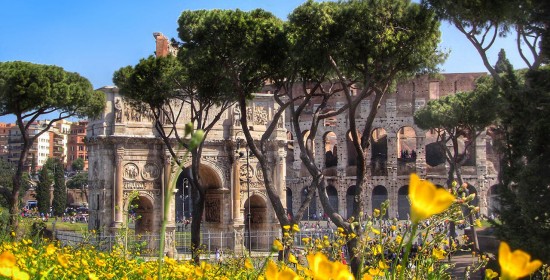
Buongiorno and welcome to Stefano’s RomeCabs, Rome’s top-rated tour company for private tours of Rome and Rome Shore Excursions from Civitavecchia.
On our exclusive Rome limousine tours, each moment unveils the splendors of history. Proudly standing in proximity to the grandeur of the Colosseum the majestic Arch of Constantine transports visitors back in time, allowing them to witness the grandeur of Emperor Constantine's victorious reign. An architectural masterpiece, the Arch of Constantine stands as an impressive testament to the power, triumphs, and enduring legacy of the Roman Empire.
Join us on a captivating journey as we delve into the rich history of the Arch of Constantine, exploring its construction, symbolic significance, and the events that shaped its creation.
History & Facts of Arch of Constantine in Rome:
A Triumph Carved in Stone
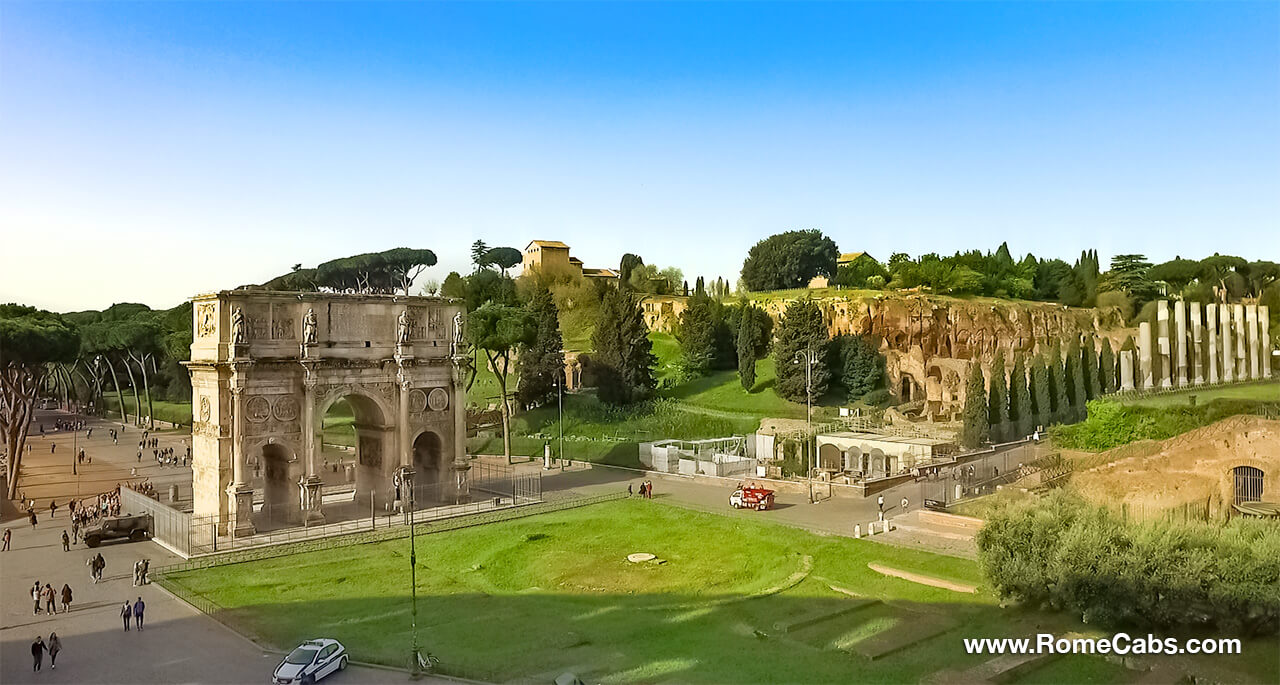
Where is the Arch of Constantine Located:
The Arch of Constantine looms majestically along Via Triumphalis between Palatine Hill and Caelian Hill and close to the Colosseum. Positioned strategically on the route traversed by triumphant military leaders during their momentous procession into the city, the arch assumed a role of immense importance.
As emperors triumphantly entered the city, they would traverse this very path, commencing their procession at the Campus Martius, weaving through the grandeur of the Circus Maximus, and around the Palatine Hill. Following the Arch of Constantine, the procession would turn left at the Meta Sudans, continuing along the Via Sacra, passing through the venerable Forum Romanum, and ascending Capitoline Hill. Along this remarkable path, both the Arches of Titus and Septimius Severus bore witness to the splendor and glory of Rome's triumphs.
A Monument to Triumph: Brief History of the Arch of Constantine
The Arch of Constantine was erected in 315 AD to commemorate the monumental victory of Emperor Constantine I over his rival Maxentius at the Battle of Milvian Bridge in 312 AD as a reminder of Constantine's military might and his subsequent rise as the undisputed ruler of the Roman Empire.
Emperor Constantine reigned from 306 to 337 AD and played a significant role in the history of Christianity. He is renowned for issuing the Edict of Milan in 313 AD, which granted religious toleration to Christians and marked a turning point in the acceptance and legalization of Christianity within the Roman Empire.
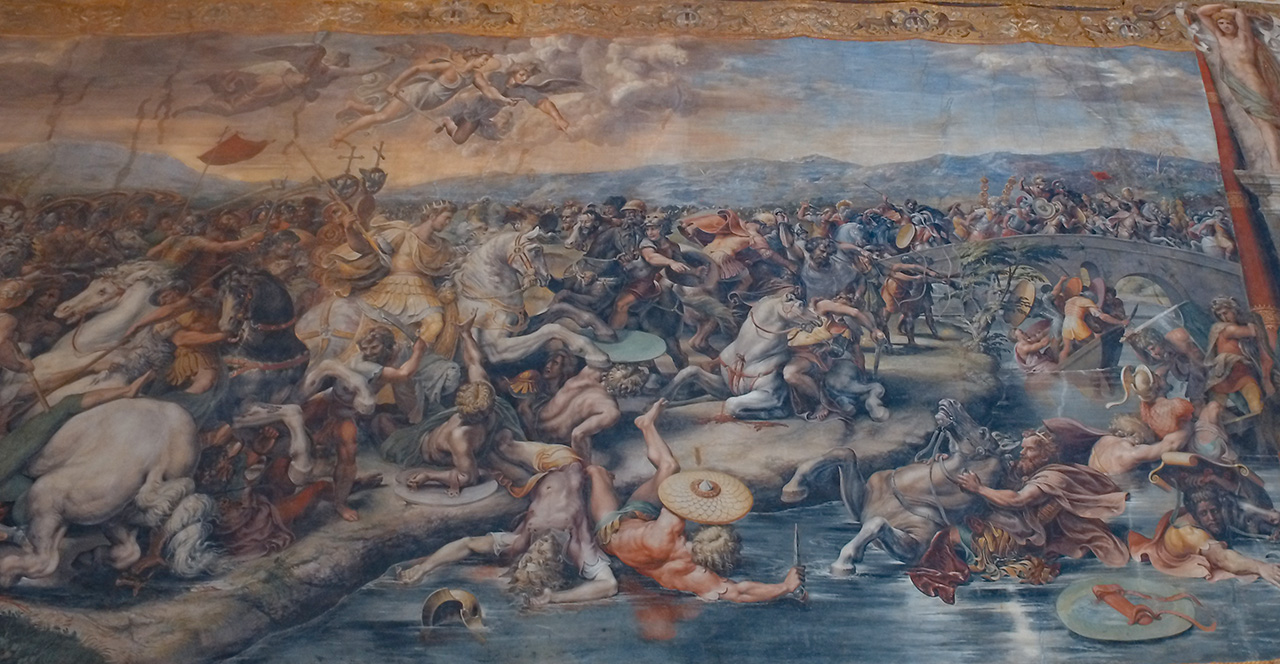
While the exact identities of the architects and sculptors involved in its construction are unknown, it is believed that a team of skilled artisans and craftsmen was responsible for creating this architectural masterpiece.
Beyond its architectural splendor, the Arch of Constantine holds immense historical significance. It marks a crucial turning point in Roman history—the triumph of Christianity. Constantine's victory at the Battle of Milvian Bridge is said to have been inspired by a vision of the Christian symbol, the Chi-Rho, which he adopted as a symbol of protection and power. The arch's reliefs depict scenes related to religious ceremonies and sacrifices, showcasing Constantine's association with Christianity and his support for the faith.
Furthermore, the arch stands as a representation of political propaganda, showcasing Constantine's legitimacy as the ruler of the Roman Empire. By incorporating reliefs and statues from earlier emperors' monuments, such as Trajan, Hadrian, and Marcus Aurelius, Constantine positioned himself as the rightful successor, connecting his reign to the greatness of his predecessors.
Arch of Constantine's Architectural Splendor
This triumphal arch stands 21 meters (69 feet) tall, 25.9 meters (85 feet) wide, and is constructed using a combination of brick and concrete, clad in opulent marble, creating a grand and imposing structure. The arch's design showcases a fusion of architectural elements from various periods, blending the traditional Roman style with influences from the Greek Hellenistic period.
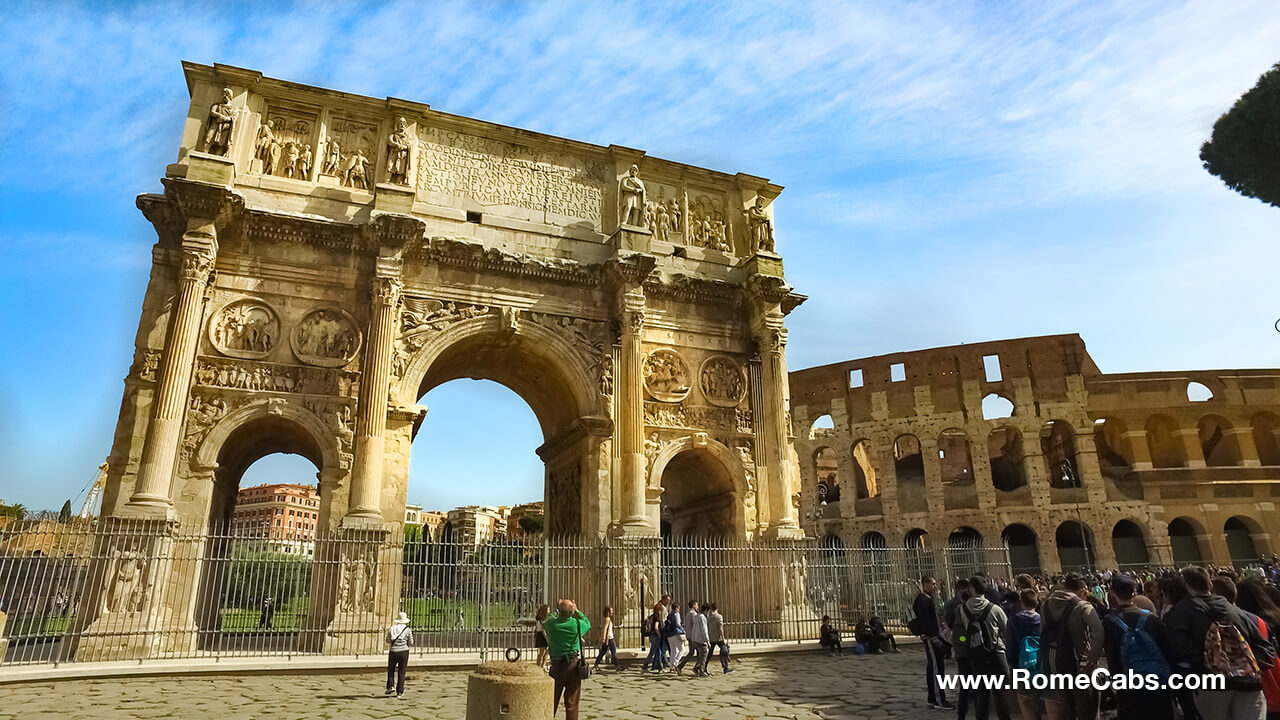
While the overall structure and design have remained relatively intact, the original appearance may have been more vibrant and colorful. The arch would have been adorned with statues, gilded accents, and perhaps additional decorative elements that have since been lost or deteriorated over time. The arch was also crowned with a quadriga, a chariot drawn by four horses, which symbolized victory. This quadriga stood on a central attic pedestal and was a prominent feature of the arch.
Despite variations and additional elements that have been lost to time, the Arch of Constantine's original form exemplified the grandeur and architectural brilliance of ancient Rome, leaving a lasting impression on those who beheld its majestic presence.
The Resurrected Splendor of Arch of Constantine's Repurposed Artwork
The Arch of Constantine incorporated numerous statues, reliefs, and architectural elements from earlier Roman monuments. What sets this triumphal arch apart is the incorporation of spolia” —reused statues and reliefs from earlier monuments.
This reuse of elements connects Constantine's reign to the greatness of his predecessors, emphasizing continuity and imperial legitimacy. These elements were taken from monuments dedicated to emperors Trajan, Hadrian, and Marcus Aurelius, showcasing the practice of spolia, the reuse of existing materials to create new structures.
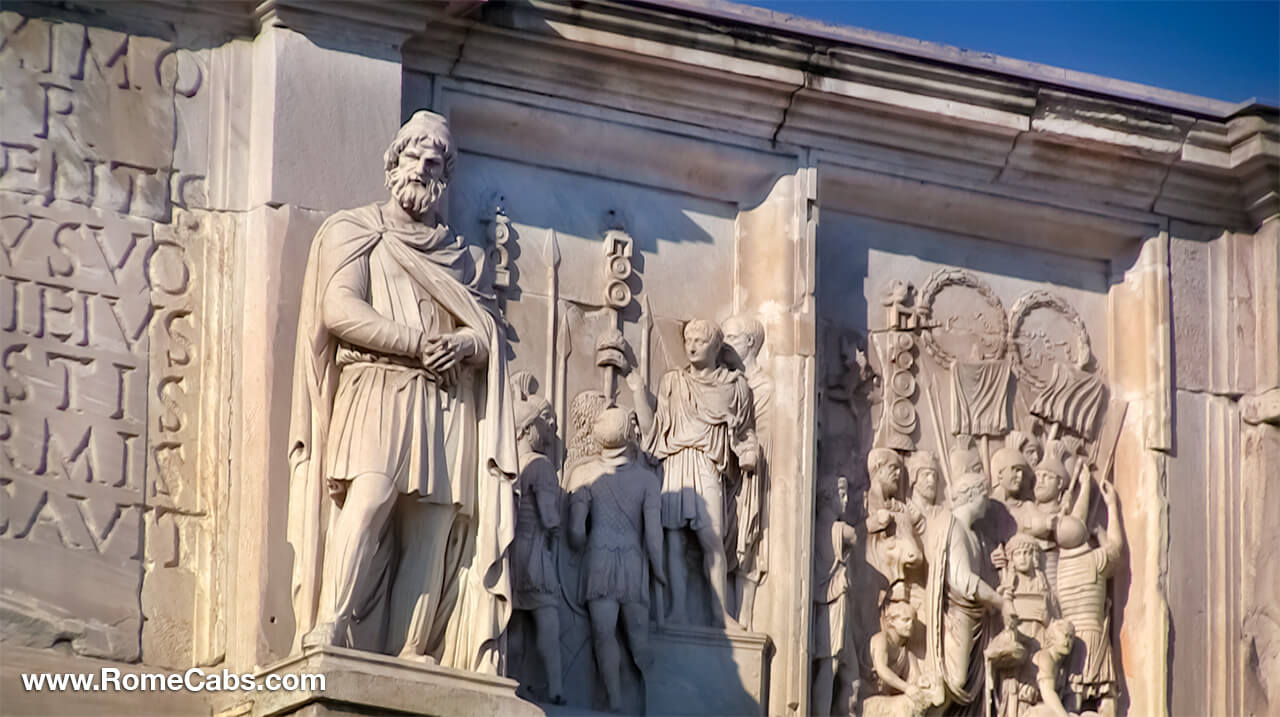
Mysterious Tales in the Intricate Reliefs of Arch of Constantine
Among the many awe-inspiring features of the Arch of Constantine in Rome, its intricate reliefs stand as a testament to the artistic prowess and storytelling ability of ancient Roman craftsmen. These intricate carvings, spread across the arch's three horizontal bands, depict pivotal moments from Emperor Constantine's military campaigns and triumphs.
The Lower Band - The Battle of Milvian Bridge:
The lower band of reliefs on the Arch of Constantine depicts the Battle of Milvian Bridge, a decisive clash between Constantine and his rival Maxentius. The scenes showcase the intense action of the battle, with soldiers engaged in combat on foot and on horseback. Warriors in detailed armor clash with enemy forces, conveying a sense of movement and chaos. The sculptors masterfully capture the tension and energy of the battlefield, highlighting the bravery and skill of Constantine's troops.
The Middle Band - Religious Ceremonies and Sacrifices:
Moving upward, the middle band showcases religious ceremonies and sacrifices. Priests and attendants are depicted performing sacred rituals, offering incense, and making animal sacrifices. The scenes represent Constantine's embrace of Christianity, highlighting his role as a pious leader. The reliefs convey a sense of solemnity and reverence, with intricate details in the drapery of the figures and the gestures of the priests.
The Upper Band - Triumphal Procession and Spoils:
The upper band of reliefs on the Arch of Constantine portrays the emperor's triumphal procession upon his return to Rome. Constantine is depicted in a chariot, surrounded by his soldiers and captives. Banners and standards flutter in the wind, and spoils of war, such as weapons and armor, are prominently displayed. The scenes capture the grandeur and pomp of the occasion, with the emperor elevated as a victorious conqueror. The reliefs showcase intricate details in the attire and expressions of the figures, conveying a sense of triumph and celebration.
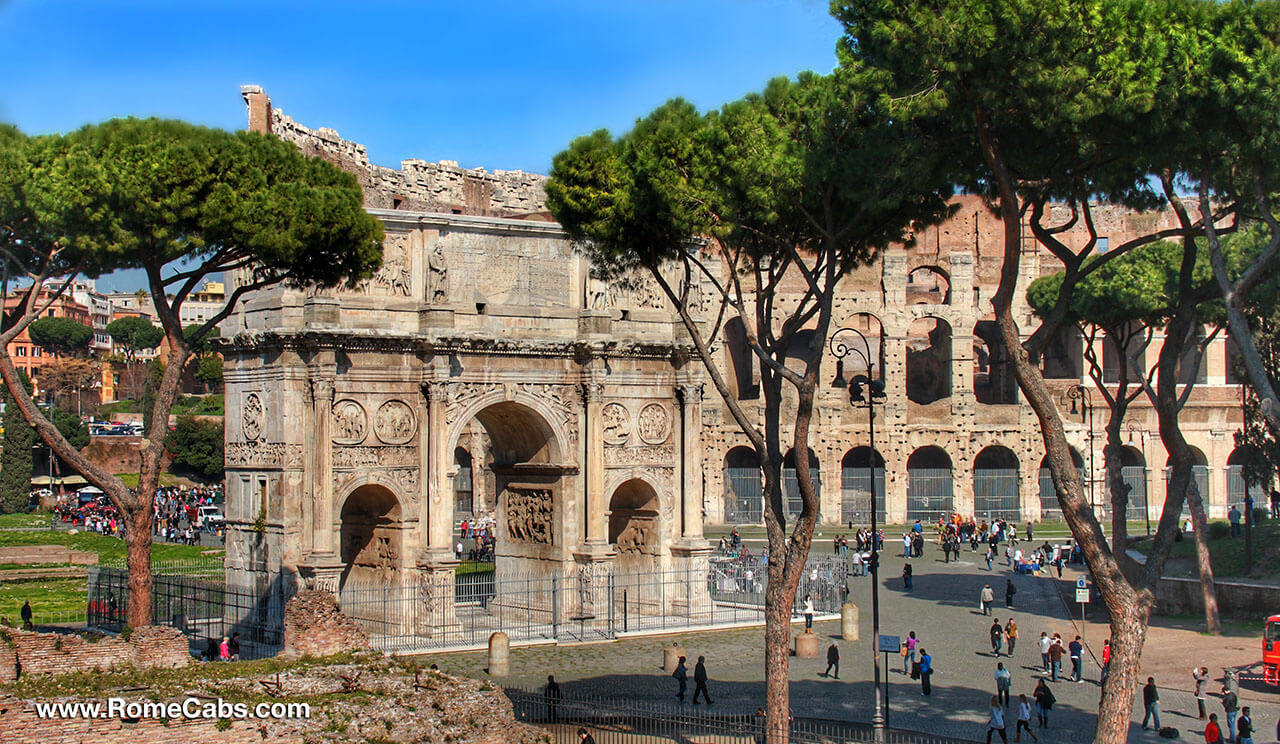
Throughout the reliefs, the craftsmanship and artistic skill of the sculptors are evident. The figures are intricately carved, with attention given to anatomical details, facial expressions, and the flow of drapery. The scenes are dynamic, conveying a sense of movement and narrative.
Preservation of the Arch of Constantine and its Modern Significance:
The preservation of the Arch of Constantine is an ongoing endeavor that aims to safeguard this iconic structure and its historical significance for future generations. As one of the most prominent landmarks in Rome, the preservation efforts surrounding the arch are essential to maintain its architectural integrity and ensure its longevity.
Preservation initiatives involve a combination of careful maintenance, restoration, and conservation techniques. The primary goal is to protect the arch from deterioration caused by environmental factors, such as weathering, pollution, and natural aging processes. Skilled conservationists and restoration specialists employ a range of methods to address specific preservation needs.
Regular cleaning is an integral part of the preservation process. Accumulated dirt, pollutants, and biological growth are carefully removed from the surfaces of the arch to prevent damage and maintain its original appearance. Additionally, expert analysis and documentation are conducted to assess the condition of the arch and identify areas that require attention.
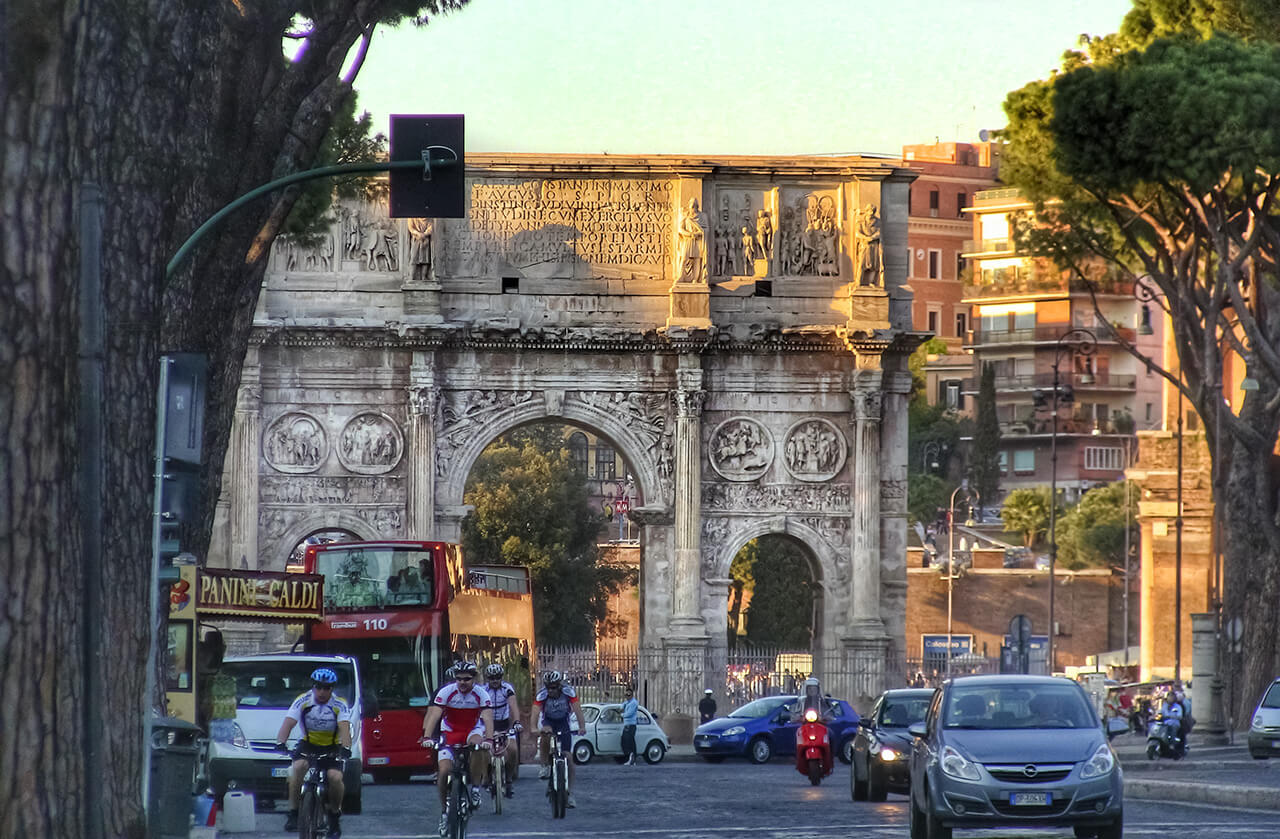
When restoration is necessary, it is carried out with meticulous precision and adherence to historical accuracy. This involves repairing damaged or deteriorated sections of the arch using compatible materials and techniques. Restoration efforts aim to retain the authenticity of the original structure while ensuring its stability and functionality.
Through the dedicated efforts of preservation professionals, the Arch of Constantine continues to stand as a symbol of Rome's rich history. By ensuring its survival and integrity, we can appreciate and learn from this remarkable structure for years to come. The preservation of the Arch of Constantine safeguards a piece of our shared cultural heritage, allowing future generations to connect with the marvels of the past.
Beyond its preservation, the Arch of Constantine holds a profound modern significance. It serves as a powerful symbol of ancient Rome's grandeur and conquests, representing the pinnacle of Roman architecture and engineering. As a testament to Emperor Constantine's victories, the arch embodies the triumphs of a bygone era and stands as a reminder of Rome's rich historical tapestry.
Moreover, the Arch of Constantine continues to inspire artists, architects, and historians alike. Its intricate reliefs, depicting scenes from Roman mythology and military campaigns, captivate viewers with their artistic brilliance and historical narrative. Scholars study its architectural techniques, gaining insights into ancient construction methods and design principles.
Today, the Arch of Constantine holds a special place in the hearts of Romans and visitors from around the world. It stands as a cherished cultural heritage site, attracting tourists who seek to immerse themselves in the grandeur of ancient Rome. The arch's prominence as a historical landmark contributes to the city's allure and serves as a reminder of the enduring power of human creativity and ingenuity.
Visiting the Arch of Constantine:
As you gracefully traverse the cobblestones of Colosseum Square, an extraordinary sight awaits—a magnificent vantage point to behold the timeless grandeur of the Arch of Constantine.
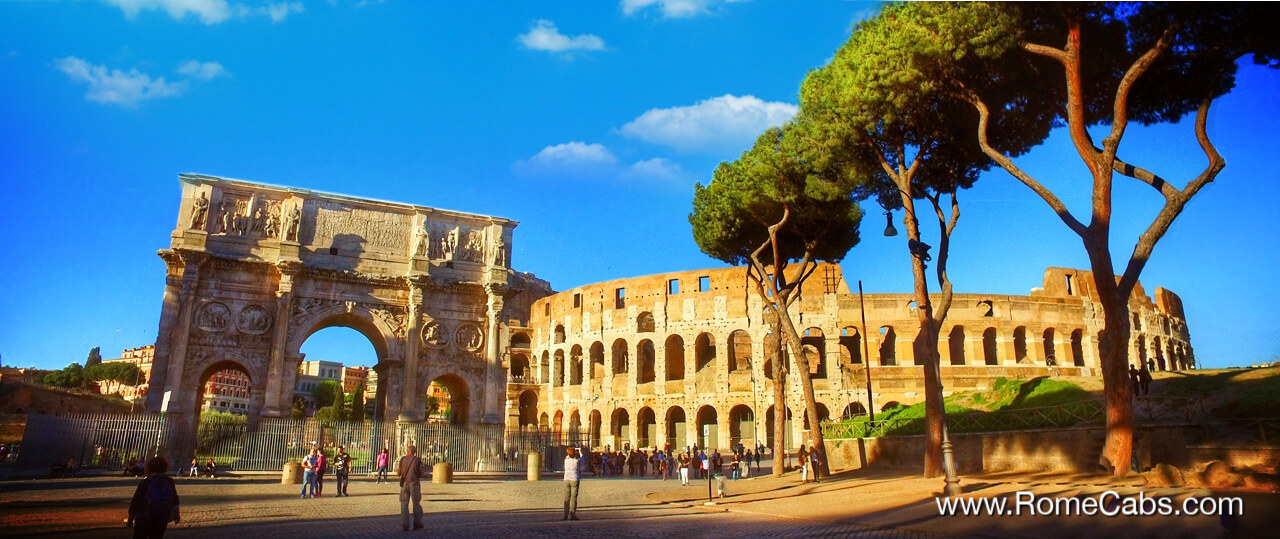
Visiting the Arch of Constantine is an immersive experience, allowing visitors to walk through history. As you approach the arch, take a moment to appreciate its scale and grandeur. Walk around its towering archway, tracing the intricate reliefs with your eyes, and imagine the triumphant processions that once passed through.
Here, amidst the harmonious fusion of past and present, you will witness an exquisite panorama of the iconic Colosseum standing proudly in all its majestic splendor. Allow this enchanting stroll to transport you to an era of ancient wonders, where history unfolds with every step, and the echoes of bygone gladiatorial triumphs fill the air.
By embarking on our Rome private tours by car or Rome Shore Excursions from Civitavecchia, visitors have the incredible opportunity to witness the Arch of Constantine firsthand, along with other awe-inspiring wonders of ancient Rome.
Our expertly crafted private tours offer a unique and immersive experience, allowing guests to delve into the fascinating wonders of Ancient Rome. As you stroll through the Colosseum Square, let the Arch of Constantine serve as a reminder of the extraordinary achievements of the past and the enduring allure of Rome's ancient wonders.
Thank you very much for reading our blog and for choosing Stefano's RomeCabs for your private tours in Italy!
* Find us online also on:
- RomeCabs FACEBOOK
- RomeCabs PINTEREST
- RomeCabs TWITTER
- RomeCabs INSTAGRAM
- RomeCabs FLICKR Photo Gallery
- Rome Cabs Recommended on Cruise Critic
- Check out more Rome Cabs Italy Travel Blogs
